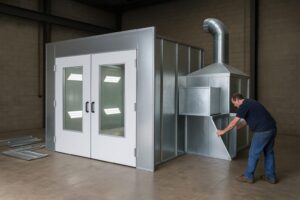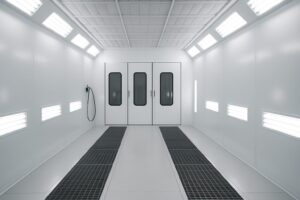When it comes to achieving a flawless finish in any paint job, lighting is more than just a helpful feature—it’s essential. Inside a paint booth, where accuracy, color matching, and surface inspection are the top priorities, the right lighting setup can make all the difference between a job well done and a costly rework.
But what does an ideal lighting setup really look like inside a paint booth? And why does it matter so much? Let’s take a closer look at what makes great lighting a key player in the painting process and how you can make sure your booth is set up for success.
Why Lighting Is a Big Deal in a Paint Booth
Think about how much painters rely on their eyes. From spotting flaws and sanding marks to ensuring an even coat or blending color perfectly, the visual component of the job is huge. If the lighting isn’t right, you risk shadows hiding defects, uneven color application, or missing spots that should have been touched up.
Proper lighting isn’t just about brightness because it’s about clarity, color accuracy, and coverage. The wrong lighting can mislead even the most experienced painter, while the right lighting helps professionals work faster, more accurately, and with more confidence.
The Goal: Mimic Natural Daylight
Natural daylight is the gold standard for painters. That’s because daylight provides a full spectrum of light, making colors appear as they truly are. In a paint booth, the aim is to recreate this kind of balanced lighting environment. But since relying on the sun isn’t practical or consistent, paint booth lights are designed to simulate daylight as closely as possible.
The key measurement here is the Color Rendering Index (CRI). CRI is a scale from 0 to 100 that tells you how accurately a light source shows colors. The higher the number, the more accurate the color rendering. For a paint booth, lighting should have a CRI of at least 90 or above. This allows painters to see the truest version of the paint color, helping with blending, matching, and spotting imperfections.
Another important factor is color temperature, which is measured in Kelvins (K). A temperature of 5000K to 6500K is ideal for paint booths because it gives off a clean, white light that resembles daylight.
Brightness Matters—But It’s About Balance
Of course, brightness is important too. The unit of measurement for brightness is lux, which is how much light hits a surface. For a paint booth, you want at least 1000 lux, but more often, booths are designed to deliver between 1000 to 1500 lux at working height.
Too little light and you can’t see fine details. Too much, and you might introduce glare or cause eye strain, which can hurt performance over long shifts. So the goal is to find that sweet spot—bright enough to see every detail, but evenly distributed so there are no harsh shadows or blinding reflections.
Even Light Distribution = Better Coverage
Ever tried painting in a room where one corner is dark and the other is flooded with light? It’s not ideal. The same goes for a paint booth.
An ideal lighting setup provides even illumination from all angles, including walls, ceiling, and sometimes even the floor. This prevents shadows from interfering with the painter’s view and allows them to maintain consistent coverage as they move around the vehicle or object.
In most professional paint booths, lights are installed in the ceiling and upper sidewalls. This surround-style lighting helps maintain visibility from every direction. Wall-mounted lights also ensure that vertical surfaces are properly lit, especially important when working on the sides of cars or larger panels.
LED Lights: The Modern Choice
While older booths often relied on fluorescent or halogen lighting, LED lighting has become the preferred choice for modern setups—and for good reason.
LEDs are more energy-efficient, generate less heat, and have a longer lifespan. They’re also available in a wide range of color temperatures and CRI ratings, which makes it easier to get that ideal daylight-style effect. Plus, since LEDs can be placed in more compact and flexible fixtures, they offer more options for booth design and light placement.
Another bonus? LEDs don’t flicker the way fluorescent lights sometimes do. Flickering might not always be noticeable, but it can cause eye fatigue over time or affect how the paint appears to the human eye.
Maintenance-Free and Dust-Proof Fixtures
It’s not just the bulb that matters, it’s the fixture too. Paint booths are high-filtration environments, and the lights used inside should be sealed, dust-proof, and easy to clean.
Look for fixtures that are rated for cleanroom or spray booth environments. These will be resistant to overspray, dust, and fumes, which helps keep the light output consistent and reduces the need for frequent maintenance.
Shatterproof covers or lens protectors are also important. The last thing you want is a broken light contaminating your freshly painted surface.
Lighting for Inspection Zones
Many paint booths now include inspection lighting zones, either as part of the booth or as a separate area. These zones are designed with even higher CRI and lux levels to allow for final checks before curing or delivering the job.
Having this kind of focused lighting area allows painters to do a quick once-over with complete confidence, checking for blemishes, swirl marks, or spots that may have been missed during the spraying process.
Boosting Workflow and Morale
Good lighting doesn’t just improve painting outcomes, it also makes the work environment more pleasant. Painters working under proper lighting report less fatigue, fewer headaches, and better overall satisfaction with their work.
It might seem like a small detail, but lighting can impact everything from productivity and accuracy to safety and employee well-being. When people can see what they’re doing clearly, they simply do better work.
So, What’s the Ideal Setup?
To wrap it up, the ideal lighting setup in a paint booth includes:
- High-CRI (90+) lights to accurately render color
- Color temperature between 5000K and 6500K to simulate daylight
- Brightness of 1000–1500 lux at working surfaces
- Even light distribution from ceiling and wall-mounted fixtures
- LED technology for energy efficiency and long-term reliability
- Sealed, dust-proof fixtures to protect against contamination
- Inspection of lighting zones for quality control
If your booth’s lighting isn’t hitting these marks, it might be time for an upgrade. The difference can be dramatic with better finishes, happier painters, and more consistent results.
At the end of the day, lighting isn’t just about visibility, it’s about precision, professionalism, and performance. In a paint booth, it’s one of the most powerful tools you can have.
How We Can Help with Your Paint Booth Needs
At Paint Booth, we specialize in providing top-tier paint booths and finishing equipment tailored to your business requirements. Whether you need a standard-size paint booth or a custom solution designed for your unique projects, our expert team is here to assist you every step of the way. From design to installation, we ensure that your equipment meets the highest industry standards, enhancing both your productivity and the quality of your finishes. Contact us today to find the perfect paint booth solution for your business!




